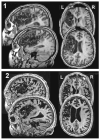From Singing to Speaking: Why Singing May Lead to Recovery of Expressive Language Function in Patients with Broca's Aphasia
- PMID: 21197418
- PMCID: PMC3010734
- DOI: 10.1525/MP.2008.25.4.315
From Singing to Speaking: Why Singing May Lead to Recovery of Expressive Language Function in Patients with Broca's Aphasia
Abstract
It has been reported that patients with severely nonfluent aphasia are better at singing lyrics than speaking the same words. This observation inspired the development of Melodic Intonation Therapy (MIT), a treatment whose effects have been shown, but whose efficacy is unproven and neural correlates remain unidentified. Because of its potential to engage/unmask language-capable regions in the unaffected right hemisphere, MIT is particularly well suited for patients with large left-hemisphere lesions. Using two patients with similar impairments and stroke size/location, we show the effects of MIT and a control intervention. Both interventions' post-treatment outcomes revealed significant improvement in propositional speech that generalized to unpracticed words and phrases; however, the MIT-treated patient's gains surpassed those of the control-treated patient. Treatment-associated imaging changes indicate that MIT's unique engagement of the right hemisphere, both through singing and tapping with the left hand to prime the sensorimotor and premotor cortices for articulation, accounts for its effect over nonintoned speech therapy.
Figures



References
-
- Albert ML, Sparks RW, Helm NA. Melodic intonation therapy for aphasia. Archives of Neurology. 1973;29:130–131. - PubMed
-
- Aziz-Zadeh L, Wilson SM, Rizzolatti G, Iacoboni M. Congruent embodied representations for visually presented actions and linguistic phrases describing actions. Current Biology. 2006;16:1818–1823. - PubMed
-
- Basso A, Gardelli M, Grassi MP, Mairotti M. The role of the right hemisphere in recovery from aphasia. Two case studies. Cortex. 1989;25:555–566. - PubMed
-
- Belin P, Van Eeckhout P, Zilbovicius M, Remy P, François C, Guillaume S, et al. Recovery from nonfluent aphasia after melodic intonation therapy: A PET study. Neurology. 1996;47:1504–1511. - PubMed
-
- Blasi V, Young AC, Tansy AP, Petersen SE, Snyder AZ, Corbetta M. Word retrieval learning modulates right frontal cortex in patients with left frontal damage. Neuron. 2002;36:159–170. - PubMed
Grants and funding
LinkOut - more resources
Full Text Sources
Medical
